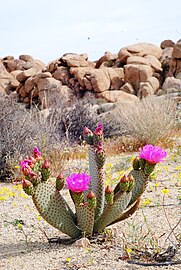Opuntia basilaris
| Opuntia basilaris | |
|---|---|

| |
| Scientific classification | |
| Kingdom: | Plantae |
| Clade: | Tracheophytes |
| Clade: | Angiosperms |
| Clade: | Eudicots |
| Order: | Caryophyllales |
| Family: | Cactaceae |
| Genus: | Opuntia |
| Species: | O. basilaris
|
| Binomial name | |
| Opuntia basilaris Engelm. & J.M.Bigelow, 1857
| |
Opuntia basilaris, the beavertail cactus or beavertail pricklypear, is a cactus species found in the southwest United States. It occurs mostly in the Mojave, Anza-Borrego, and Colorado Deserts, as well as in the Colorado Plateau and northwest Mexico. It is also found throughout the Grand Canyon and Colorado River region as well as into southern Utah and Nevada, and in the western Arizona regions along the Lower Colorado River Valley.[2][3]
Description[]
Opuntia basilaris is a medium-sized to small prickly pear cactus 70–400 mm (2.8–15.7 in) tall, with pink to rose colored flowers. A single plant may consist of hundreds of fleshy, flattened pads. These are more or less blue-gray, depending on variety, 50–210 mm (2.0–8.3 in) long and less than 100 mm (3.9 in) wide and 10–15 mm (0.4–0.6 in) thick. They are typically spineless, but as is typical for Opuntia species, have many small barbed bristles, called glochids, that easily penetrate the skin. Opuntia basilaris blooms from spring to early summer.[2][3][4]

Deep magenta-red filaments and white to pink style[2]

Buds, in Joshua Tree National Park

Flowers, in Joshua Tree National Park
Varieties[]
The species is variable in nature and several names under different ranks have been described. Only four of these are generally accepted.
- Opuntia basilaris var. basilaris (2n=22)
- Opuntia basilaris var. brachyclada (2n=22) - Little beavertail pricklypear
- Opuntia basilaris var. heilii (2n=22) - Heil's beavertail
- Opuntia basilaris var. longiareolata (2n=22) - Elongated beavertail prickly pear or Grand Canyon beavertail pricklypear
- Opuntia basilaris var. treleasei(2n=33) - Trelease's beavertail prickly pear, Bakersfield cactus (This variety is designated as endangered under the federal Endangered Species Act and California Endangered Species Act, which means that killing or possessing it is prohibited in California)
Some experts consider the Trelease's beavertail to be a full species (Bowen 1987, R. van de Hoek). It is unique among the varieties of Opuntia basilaris in that the areoles contain spines in addition to the bristles; this indicates that the species does vary a lot in its exterior.
Chemistry[]
Opuntia basilaris contains 0.01% mescaline and 4-hydroxy-3-5-dimethoxyphenethylamine.[5]
Uses[]
The Cahuilla Native Americans used beavertail as a food staple. The buds were cooked or steamed, and then were eaten or stored. The large seeds were ground up to be eaten as mush.[6]
References[]
- ^ Pinkava, D.J., Baker, M. & Puente, R. 2017. Opuntia basilaris (amended version of 2013 assessment). The IUCN Red List of Threatened Species 2017: e.T152316A121587572. https://dx.doi.org/10.2305/IUCN.UK.2017-3.RLTS.T152316A121587572.en. Downloaded on 29 August 2021.
- ^ Jump up to: a b c d "Opuntia basilaris". in Jepson Flora Project (eds.) Jepson eFlora. Jepson Herbarium; University of California, Berkeley. 2018. Retrieved 2018-07-06.
- ^ Jump up to: a b Sullivan, Steven. K. (2018). "Opuntia basilaris". Wildflower Search. Retrieved 2018-07-06.
- ^ "Opuntia basilaris". Opuntia Web.
- ^ "Plant Chemistry".
- ^ "Temalpakh Ethnobotanical Garden". Malki Museum. Retrieved 2018-07-06.
External links[]
 Media related to Opuntia basilaris at Wikimedia Commons
Media related to Opuntia basilaris at Wikimedia Commons- Flora of North America; RangeMap
- Arizona Salvage Restricted Protected Native Plants
- Photo gallery
- Opuntia basilaris photo gallery at Opuntia Web
- Malki Museum
- IUCN Red List least concern species
- Opuntia
- Cacti of Mexico
- Cacti of the United States
- Flora of the California desert regions
- Flora of the Sonoran Deserts
- Flora of Arizona
- Flora of California
- Flora of Baja California
- Flora of Sonora
- Flora of Utah
- Flora of the Sierra Nevada (U.S.)
- Natural history of the California chaparral and woodlands
- Natural history of the Central Valley (California)
- Natural history of the Colorado Desert
- Natural history of the Grand Canyon
- Natural history of the Mojave Desert
- Natural history of the Peninsular Ranges
- Natural history of the Transverse Ranges
- North American desert flora





